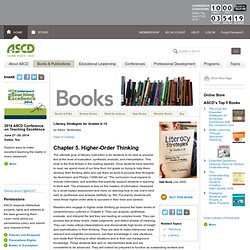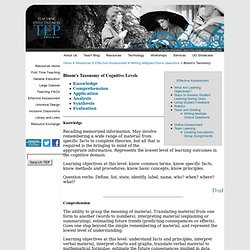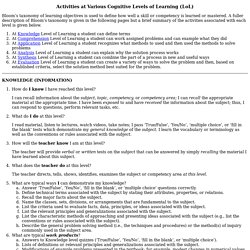Zoom
Trash

Higher-Order Thinking. Although most teachers learned about Bloom's Taxonomy (Bloom, 1956) during their preparation courses, many seldom challenge students beyond the first two levels of cognition: knowledge and comprehension.

Because most jobs in the 21st century will require employees to use the four highest levels of thinking—application, analysis, synthesis, and evaluation—this is unacceptable in today's instructional programs. We must expect students to operate routinely at the higher levels of thinking. Bloom's original taxonomy has certainly withstood the test of time, but a newer version has been introduced to reflect more contemporary thinking. Recently a former student of Bloom, Lorin Anderson, and a group of cognitive psychologists published a revised version of Bloom's taxonomy (Anderson & Krathwohl, 2001).
Bloom's original six categories were nouns: knowledge, comprehension, application, analysis, synthesis, and evaluation. Revised Category #1: Knowledge → Remember Doing Well on High-Stakes Tests. Bloom's Taxonomy. Blooms Taxonomy Action Verbs.pdf (application/pdf Object) Blooms_taxonomy.pdf (application/pdf Object) Bloom's Taxonomy of Cognitive Levels. Knowledge Recalling memorized information.

May involve remembering a wide range of material from specific facts to complete theories, but all that is required is the bringing to mind of the appropriate information. Represents the lowest level of learning outcomes in the cognitive domain. Learning objectives at this level: know common terms, know specific facts, know methods and procedures, know basic concepts, know principles.
Question verbs: Define, list, state, identify, label, name, who? [Top] Comprehension The ability to grasp the meaning of material. Learning objectives at this level: understand facts and principles, interpret verbal material, interpret charts and graphs, translate verbal material to mathematical formulae, estimate the future consequences implied in data, justify methods and procedures. Question verbs: Explain, predict, interpret, infer, summarize, convert, translate, give example, account for, paraphrase x? Application Question verbs: How could x be used to y? Analysis. Bloom's Taxonomy. Bloom identified six levels within the cognitive domain, from the simple recall or recognition of facts, as the lowest level, through increasingly more complex and abstract mental levels, to the highest order which is classified as evaluation. A description of the six levels as well as verb examples that represent intellectual activity are listed here. Knowledge is defined as remembering of previously learned material.
This may involve the recall of a wide range of material, from specific facts to complete theories, but all that is required is the bringing to mind of the appropriate information. Knowledge represents the lowest level of learning outcomes in the cognitive domain. Definitions of Bloom's Taxonomy. Activities at Various Cognitive Levels of Learning (LoL) Bloom’s taxonomy of learning objectives is used to define how well a skill or competency is learned or mastered.

A fuller description of Bloom’s taxonomy is given in the following pages but a brief summary of the activities associated with each level is given below. At Knowledge Level of Learning a student can define terms At Comprehension Level of Learning a student can work assigned problems and can example what they did At Application Level of Learning a student recognizes what methods to used and then used the methods to solve problems At Analysis Level of Learning a student can explain why the solution process works At Synthesis Level of Learning a student can combine the part of a process in new and useful ways At Evaluation Level of Learning a student can create a variety of ways to solve the problem and then, based on established criteria, select the solution method best suited for the problem.
What do I do at this level?